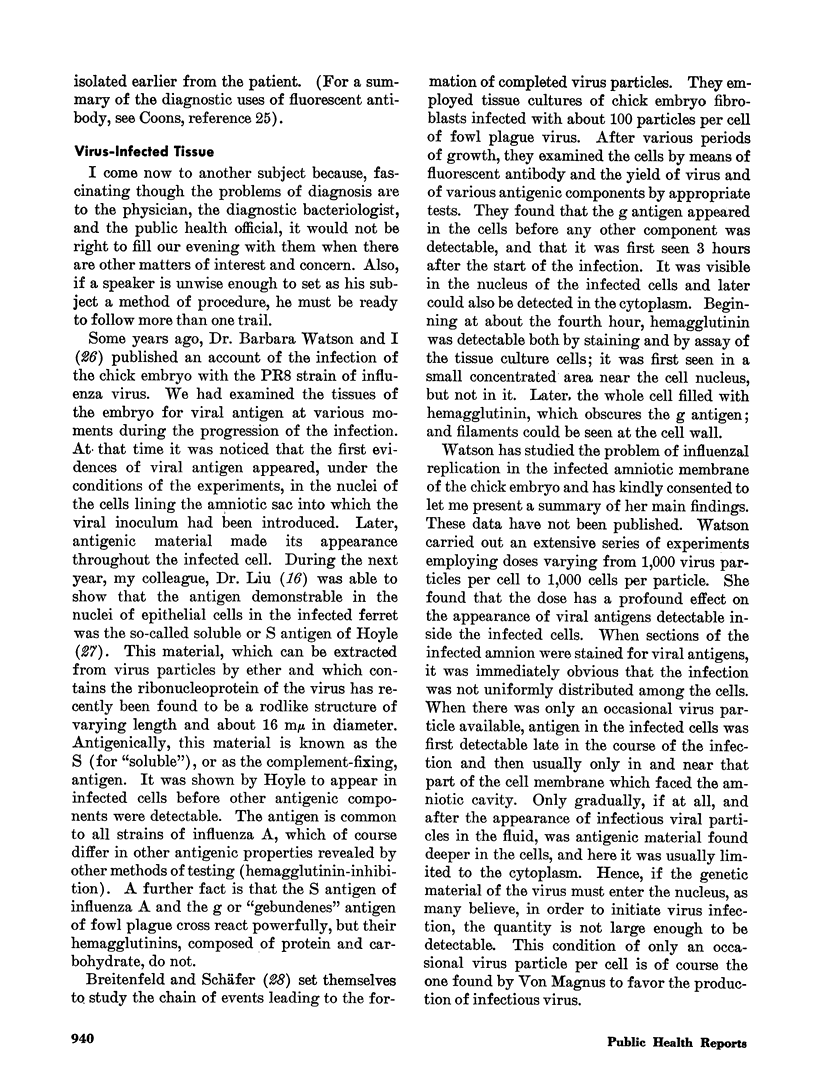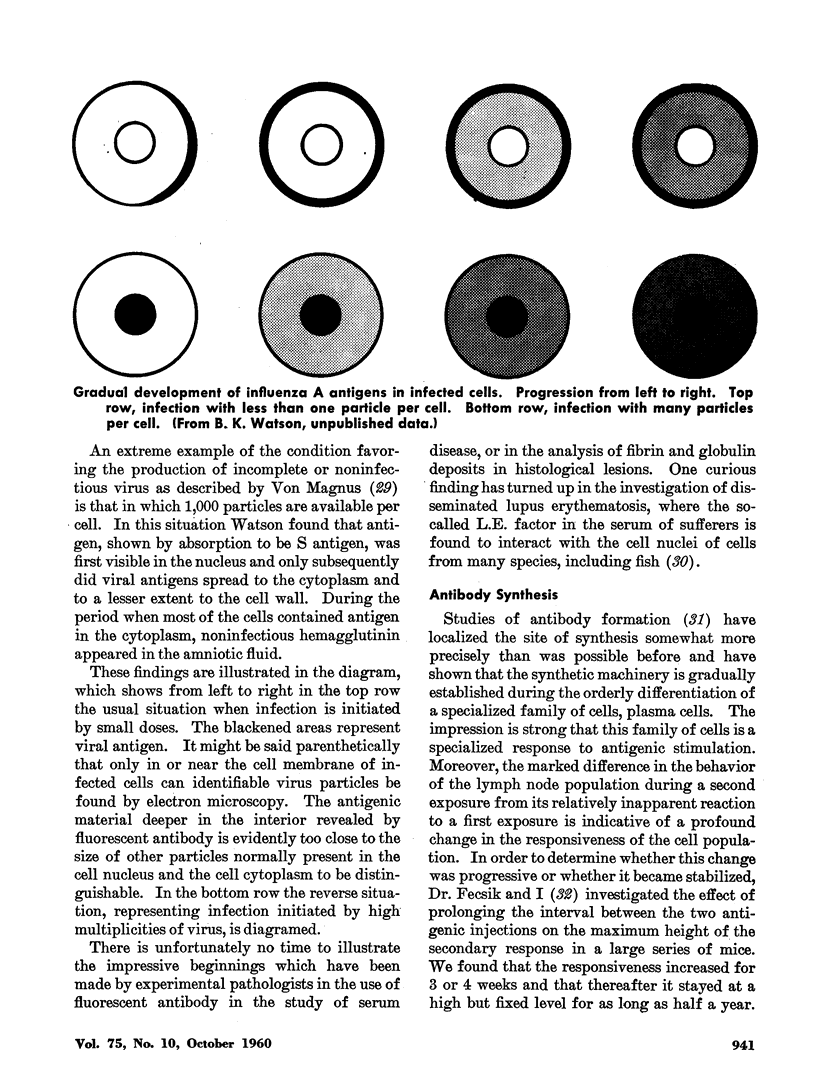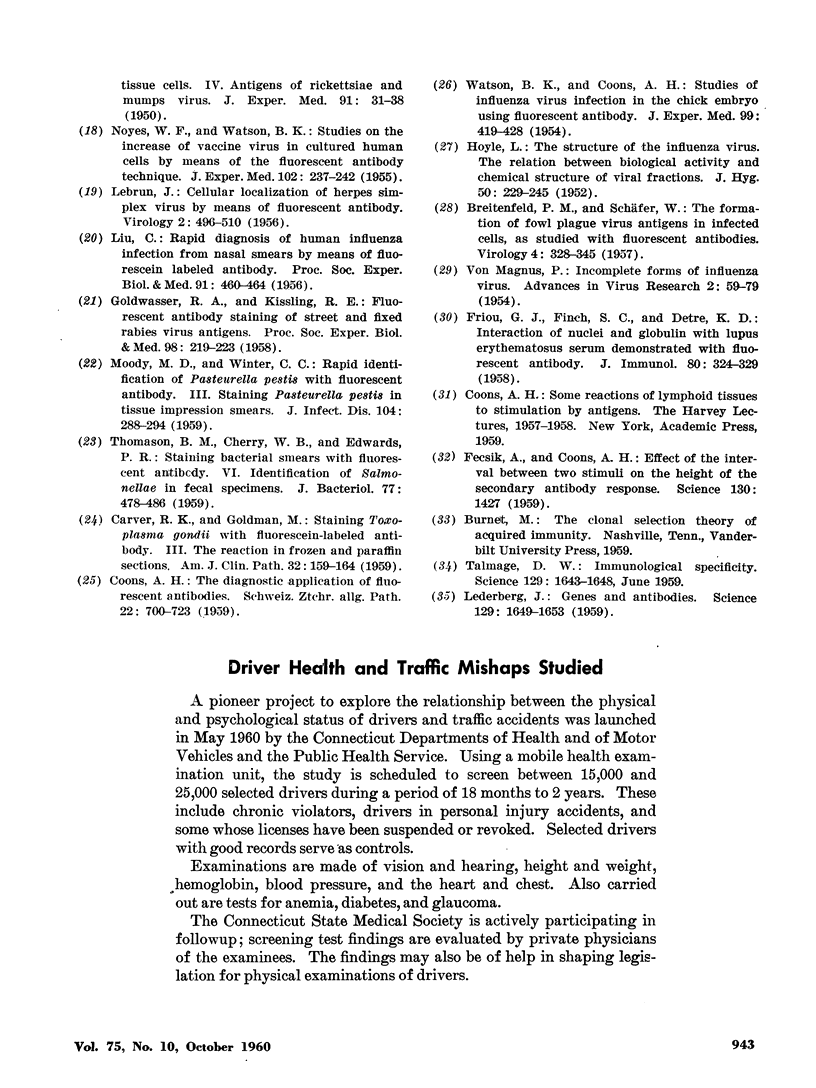Full text
PDF






Selected References
These references are in PubMed. This may not be the complete list of references from this article.
- BREITENFELD P. M., SCHAFER W. The formation of fowl plague virus antigens in infected cells, as studied with fluorescent antibodies. Virology. 1957 Oct;4(2):328–345. doi: 10.1016/0042-6822(57)90067-3. [DOI] [PubMed] [Google Scholar]
- CARVER R. K., GOLDMAN M. Staining Toxoplasma gondii with fluorescein-labeled antibody. III. The reaction in frozen and paraffin sections. Am J Clin Pathol. 1959 Aug;32(2):159–164. doi: 10.1093/ajcp/32.2.159. [DOI] [PubMed] [Google Scholar]
- CLAYTON R. M. Localization of embryonic antigens by antisera labelled with fluorescent dyes. Nature. 1954 Dec 4;174(4440):1059–1059. doi: 10.1038/1741059a0. [DOI] [PubMed] [Google Scholar]
- DIXON F. J., TALMAGE D. W., MAURER P. H., DEICHMILLER M. The half-life on homologous gamma globulin (antibody) in several species. J Exp Med. 1952 May;95(5):313–318. doi: 10.1084/jem.96.4.313. [DOI] [PMC free article] [PubMed] [Google Scholar]
- FRIOU G. J., FINCH S. C., DETRE K. D. Interaction of nuclei and globulin from lupus erythematosis serum demonstrated with fluorescent antibody. J Immunol. 1958 Apr;80(4):324–329. [PubMed] [Google Scholar]
- GOLDWASSER R. A., KISSLING R. E. Fluorescent antibody staining of street and fixed rabies virus antigens. Proc Soc Exp Biol Med. 1958 Jun;98(2):219–223. doi: 10.3181/00379727-98-23996. [DOI] [PubMed] [Google Scholar]
- HOBSON P. N., MANN S. O. Some studies on the identification of rumen bacteria with fluorescent antibodies. J Gen Microbiol. 1957 Apr;16(2):463–471. doi: 10.1099/00221287-16-2-463. [DOI] [PubMed] [Google Scholar]
- HOYLE L. Structure of the influenza virus; the relation between biological activity and chemical structure of virus fractions. J Hyg (Lond) 1952 Jun;50(2):229–245. doi: 10.1017/s0022172400019562. [DOI] [PMC free article] [PubMed] [Google Scholar]
- Hopkins S. J., Wormall A. Phenyl isocyanate protein compounds and their immunological properties. Biochem J. 1933;27(3):740–753. doi: 10.1042/bj0270740. [DOI] [PMC free article] [PubMed] [Google Scholar]
- KABAT E. A. Heterogeneity in extent of the combining regions of human antidextran. J Immunol. 1956 Dec;77(6):377–385. [PubMed] [Google Scholar]
- LEBRUN J. Cellular localization of Herpes simplex virus by means of fluorescent antibody. Virology. 1956 Aug;2(4):496–510. doi: 10.1016/0042-6822(56)90006-x. [DOI] [PubMed] [Google Scholar]
- LEDERBERG J. Genes and antibodies. Science. 1959 Jun 19;129(3364):1649–1653. doi: 10.1126/science.129.3364.1649. [DOI] [PubMed] [Google Scholar]
- LIU C. Studies of influenza infection in ferrets by means of fluorescein-labelled antibody. I. The pathogenesis and diagnosis of the disease. J Exp Med. 1955 Jun 1;101(6):665–676. doi: 10.1084/jem.101.6.665. [DOI] [PMC free article] [PubMed] [Google Scholar]
- MARSHALL J. D., EVELAND W. C., SMITH C. W. Superiority of fluorescein isothiocyanate (Riggs) for fluorescent-antibody technic with a modification of its application. Proc Soc Exp Biol Med. 1958 Aug-Sep;98(4):898–900. doi: 10.3181/00379727-98-24222. [DOI] [PubMed] [Google Scholar]
- MAYERSBACH H. Immunhistologische Methoden. II. Ein weiterer Markierungsfarbstoff: Dimethyl-1-Naphthylaminsulfonsäure-5. Acta Histochem. 1958 Jun 27;5(5-8):351–368. [PubMed] [Google Scholar]
- MOODY M. D., WINTER C. C. Rapid identification of Pasteurella pestis with fluorescent antibody. III. Staining Pasteurella pestis in tissue impression smears. J Infect Dis. 1959 May-Jun;104(3):288–294. doi: 10.1093/infdis/104.3.288. [DOI] [PubMed] [Google Scholar]
- NOYES W. F., WATSON B. K. Studies on the increase of vaccine virus in cultured human cells by means of the fluorescent antibody technique. J Exp Med. 1955 Sep 1;102(3):237–242. doi: 10.1084/jem.102.3.237. [DOI] [PMC free article] [PubMed] [Google Scholar]
- RIGGS J. L., SEIWALD R. J., BURCKHALTER J. H., DOWNS C. M., METCALF T. G. Isothiocyanate compounds as fluorescent labeling agents for immune serum. Am J Pathol. 1958 Nov-Dec;34(6):1081–1097. [PMC free article] [PubMed] [Google Scholar]
- TALMAGE D. W. Immunological specificity, unique combinations of selected natural globulins provide an alternative to the classical concept. Science. 1959 Jun 19;129(3364):1643–1648. doi: 10.1126/science.129.3364.1643. [DOI] [PubMed] [Google Scholar]
- THOMASON B. M., CHERRY W. B., EDWARDS P. R. Staining bacterial smears with fluorescent antibody. VI. Identification of Salmonellae in fecal specimens. J Bacteriol. 1959 Apr;77(4):478–486. doi: 10.1128/jb.77.4.478-486.1959. [DOI] [PMC free article] [PubMed] [Google Scholar]
- VON MAGNUS P. Incomplete forms of influenza virus. Adv Virus Res. 1954;2:59–79. doi: 10.1016/s0065-3527(08)60529-1. [DOI] [PubMed] [Google Scholar]
- WATSON B. K., COONS A. H. Studies of influenza virus infection in the chick embryo using fluorescent antibody. J Exp Med. 1954 May 1;99(5):419–428. doi: 10.1084/jem.99.5.419. [DOI] [PMC free article] [PubMed] [Google Scholar]


